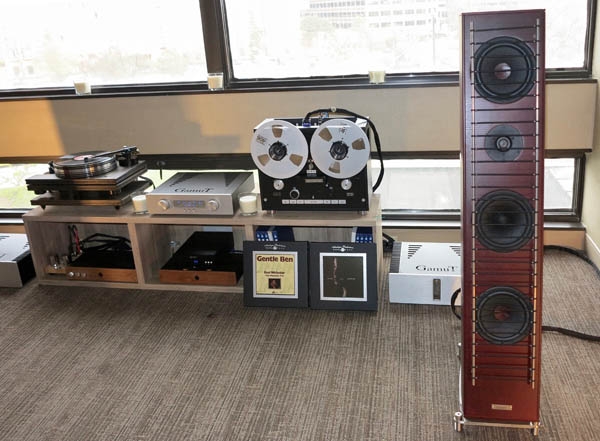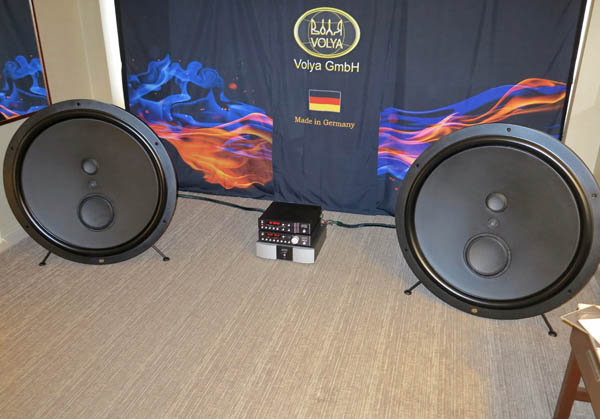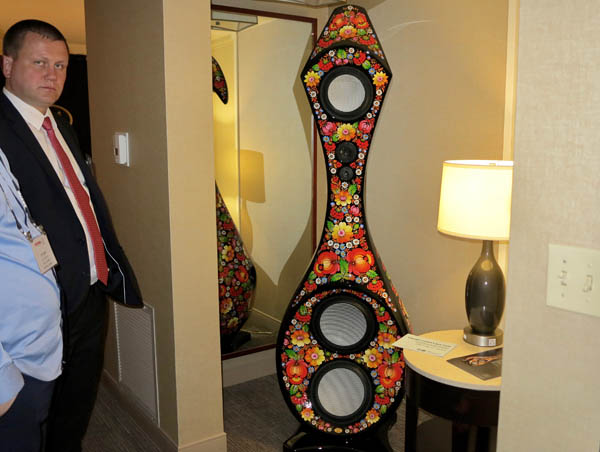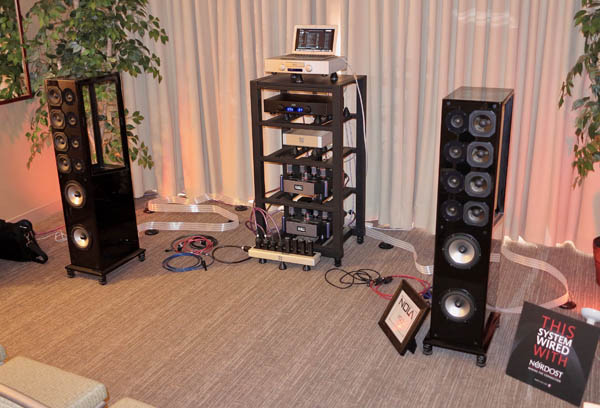| Columns Retired Columns & Blogs |
What were those acoustical treatment devices on the window sills in the GamuT room?
Also, do you recall your impressions of the midrange balance in that room?

Note that Meldgaard had intentionally removed the curtains in the room, and relied instead on fine-positioning of the GamuT RS7i speakers ($39,990/pair). Also in use: GamuT M250i monoblocks ($25,990/pair) and reference cables; Pear Audio Blue Kid Thomas turntable with Cornet 2 tonearm ($7995) with optional power supply ($1995) and Ortofon Cadenza Black cartridge ($2729), and Pear Audio Blue Reference phono preamp ($4495).
 One of the big eye catchers at AXPONA was the Volya NoLimits loudspeaker from Germany ($33,000/pair). Not currently distributed in the US, these round babies, with 88dB sensitivity, 4 ohm impedance, and a claimed frequency range of 25Hz–27kHz, have a metal enclosure with "vibration-absorbing filled steel elements and fiberglass armored composite with inner stiffeners." Inside is ultra-pure copper cable and crossover components from Mundorf. All drivers are from Accuton—the 11" woofer has a Kevlar and ceramic sandwich membrane, the 5" midrange and 1" tweeter ceramic membranes. Connection terminals are from WBT.
One of the big eye catchers at AXPONA was the Volya NoLimits loudspeaker from Germany ($33,000/pair). Not currently distributed in the US, these round babies, with 88dB sensitivity, 4 ohm impedance, and a claimed frequency range of 25Hz–27kHz, have a metal enclosure with "vibration-absorbing filled steel elements and fiberglass armored composite with inner stiffeners." Inside is ultra-pure copper cable and crossover components from Mundorf. All drivers are from Accuton—the 11" woofer has a Kevlar and ceramic sandwich membrane, the 5" midrange and 1" tweeter ceramic membranes. Connection terminals are from WBT.
The NoLimits' pairing with a Mark Levinson No.390S CD Processor, No.380S preamp, and No.431 power amp, all connected by AudioQuest cabling, proved a bit metallic in the treble and lacking in ultimate liquidity. On one of my reveal-so-much fallback tracks, pianist Murray Perahia's stunning rendition of the final movement of Handel's Suite for Harpsichord in E, notes were too staccato, and lacking a sense of connectedness. That, of course, could be as much a function of set-up and room issues as anything else.
Volya GmbH, in association with the High End Society GmbH and the University Hospital of Saarland at Homburg, has launched a Charity Auction of a pair of Volya NoLimits loudspeakers that will benefit the Division of Pediatric Ophthalmology at the University Hospital of Saarland (UKS). See www.volya.audio.
 On static display in the room's cramped alcove was the hand-painted, diamond tweeter- and midrange-equipped Volya Bouquet ($30,000/pair). Less sensitive than the above-described NoLimits—the Bouquet is specified as 86dB—but boasting a larger frequency range of 25Hz–50kHz, the bass-reflex design with rear port is a guaranteed conversation piece. With images swirling through my head of the babushkas worn by generations of Russian women, and flashbacks of older women haggling over prices at vegetable stands on the streets of New York's Lower East Side ca 1971, I thanked the gentlemen and moved on.
On static display in the room's cramped alcove was the hand-painted, diamond tweeter- and midrange-equipped Volya Bouquet ($30,000/pair). Less sensitive than the above-described NoLimits—the Bouquet is specified as 86dB—but boasting a larger frequency range of 25Hz–50kHz, the bass-reflex design with rear port is a guaranteed conversation piece. With images swirling through my head of the babushkas worn by generations of Russian women, and flashbacks of older women haggling over prices at vegetable stands on the streets of New York's Lower East Side ca 1971, I thanked the gentlemen and moved on.
 Nola has just introduced its new KO 2 loudspeaker ($14,000/pair). The successor to the KO, it promises greater low-level resolution via eight new woven carbon-fiber midrange drivers with edge-wound Kapton voice coils and cast-aluminum frames, upgraded crossover boards, and re-tuned low-frequency chambers. Internal wiring includes Nordost monofilament silver. To quote designer Carl Marchisotto, "Everything except the two woofers is new. We've even switched cabinet building to Riverside, CA."
Nola has just introduced its new KO 2 loudspeaker ($14,000/pair). The successor to the KO, it promises greater low-level resolution via eight new woven carbon-fiber midrange drivers with edge-wound Kapton voice coils and cast-aluminum frames, upgraded crossover boards, and re-tuned low-frequency chambers. Internal wiring includes Nordost monofilament silver. To quote designer Carl Marchisotto, "Everything except the two woofers is new. We've even switched cabinet building to Riverside, CA."
In combination with Nordost Frey interconnects and Valhalla 2 speaker cable; Hegel CD player and preamp/DAC; and a 100Wpc Manley Snapper tube amp, transparency was excellent. On a recording of "Autumn Leaves" (performed by the ever-popular Jason-you-forgot-to-write-it-down!), the system beautifully captured the complex harmonic structure of the instruments, but was a little hot on top.
 For the last of what seems to have been 17 rooms auditioned in six hours, I visited the Emerald Physics room. Through the new Emerald Physics EP-4.8 open-baffle, controlled-dispersion loudspeakers ($8495/pair), Murray Perahia's piano sounded a mite brittle on top and wanting for midrange warmth. Both the imaging and sense of acoustic space were excellent, as is par for the course for Emerald Physics. The EP-4.8s, I might add, use no DSP.
For the last of what seems to have been 17 rooms auditioned in six hours, I visited the Emerald Physics room. Through the new Emerald Physics EP-4.8 open-baffle, controlled-dispersion loudspeakers ($8495/pair), Murray Perahia's piano sounded a mite brittle on top and wanting for midrange warmth. Both the imaging and sense of acoustic space were excellent, as is par for the course for Emerald Physics. The EP-4.8s, I might add, use no DSP.
Also in the system: new Emerald Physics EP200.2SE 200Wpc hybrid dual-mono digital amplifier/controller with analog power supply ($3495); Exogal Comet Plus DSD/PCM DAC ($3495 with power supply); Emerald Physics Bass Optimization Module ($499); and Core Power Technologies Equi=Core 1800 15A balanced power unit ($1799). Sources were Tidal and a Mac Mini, as well as a Cambridge CD player used as a transport.

What were those acoustical treatment devices on the window sills in the GamuT room?
Also, do you recall your impressions of the midrange balance in that room?

The system was AOK in the midrange. The midrange certainly wasn't dominant, that's for certain. Then again, when is it dominant in live performance, other than in very dry halls which truncate the top?
Those "devices" are candles. They're also on the equipment stand.

Acoustic wax candles?

SR ART acoustic candles.

I always enjoy your coverage of these events. Thanks...